About St. Thomas More College
We acknowledge that we are on Treaty Six Territory and the Homeland of the Métis. We respect and reaffirm our relationship with one another.
1. St. Thomas More College is a Catholic college and an inclusive community.
- Founded by the Congregation of Saint Basil in 1936
- Any USask students can select from over 220 Arts and Science credit classes through STM
- STM provides opportunities for students to grow intellectually as well as spiritually
- STM is committed to social justice and the common good
- Support and camaraderie is available through the STM Campus Ministry team and Newman Club
- STM is home to a beautiful chapel where Roman Catholic Mass and Byzantine Divine Liturgy is celebrated
2. St. Thomas More College has a Liberal Arts focus.
While STM students may choose any major offered by the College of Arts and Sciences at USask, our teaching focus is:
- Humanities: English, history, languages and linguistics, philosophy, religious studies
- Social Sciences: anthropology, archaeology, economics, political studies, psychology, sociology
3. St. Thomas More College is federated with the University of Saskatchewan (USask).
While we maintain our own administration and receive our own provincial grants, we are academically integrated with the University of Saskatchewan. That means:
- We offer classes that students take as part of their USask degrees
- Students in any USask college may take STM classes
- Our professors are fully certified: they are members of the faculty of the College of Arts & Science and of University Council
- Any Arts and Science student may additionally self-declare as a St. Thomas More College student. (Such a student will officially be an STM student, but will still be an Arts & Science student at USask at the same time.)
College History
More Rejoicing is a historical overview of the college and was published for the 75th Anniversary of St. Thomas More College in 2011.
Overview
The origins of St. Thomas More College go back to 1913 when Saskatoon Catholics first requested a Catholic college for the newly-established University of Saskatchewan. For a number of reasons, nothing came of the request until April 1926 when a group of Saskatoon Catholic laity formed a group called the Newman Society to work actively for the establishment of such a college. By September of that year, arrangements were in place for Fr. Dr. Basil Markle from the Archdiocese of Toronto to teach Scholastic Philosophy at the University of Saskatchewan and to serve as chaplain for the Catholic students. Newman Hall ("the white house") was built in 1927 and the student Newman Club was formed in the fall of 1928.
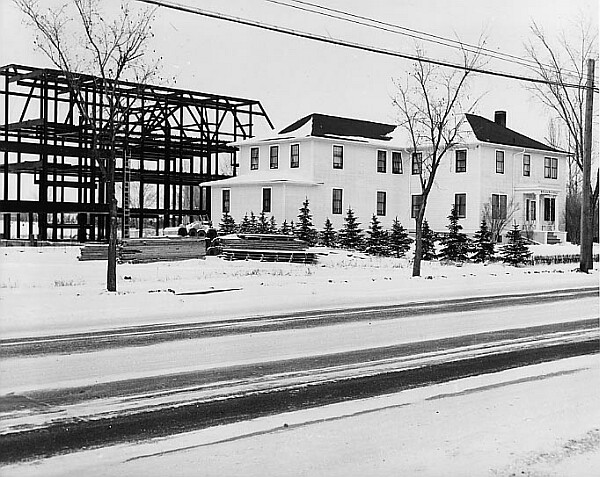 |
| In 1927, Newman Hall (“the white house”) was built on the corner of College Drive & Bottomley Avenue. The new stone clad St. Thomas More College was constructed (1955 to 1957) around the wooden building which was eventually demolished. |
In 1936, the long-awaited college was established by the Basilian Fathers of Toronto as a Catholic liberal arts college in federation with the University of Saskatchewan. At that time, the college was placed under the patronage of St. Thomas More, who had been canonized in 1935. The new college's relationship with the university was modeled on that of St. Michael's College at the University of Toronto. In its first year, 1936-37, St. Thomas More College had a teaching faculty of four, and a grand total of 39 students.
From 1937 until the mid-1960s, the faculty of the college was made up entirely of Basilian Fathers. With the continuing growth of the student body and the addition of a number of lay faculty, changes in the administrative structures and an enlargement of the college corporation were called for and these changes were introduced in 1971.
The present stone building was constructed in three stages between 1954 and 1969 and includes a chapel, library, cafeteria, auditorium, offices, classrooms and an art gallery. St. Thomas More College's chapel is the home of a number of fine works of original art, including stained glass windows by Robert Rambusch and murals by Lionel Thomas and William Kurelek.
White House Years (1926-1956)
The Beginnings
The first public indication of the Saskatoon Catholic community's desire to have a Catholic college at the University of Saskatchewan came in 1913 when, on behalf of a group of Saskatoon Catholic parents, John Joseph Leddy presented the idea to Bishop Albert Pascal, bishop of the Diocese of Prince Albert and Saskatoon. Although the bishop indicated approval for the establishment of a Catholic college at the University, for various reasons there was no further action on the proposal for several years.
After the end of the Great War in 1918, it looked as if some progress would be forthcoming on the Catholic college project. In March, 1919, the need for a Catholic college at the university was the subject of a Pastoral Letter from Bishop Pascal, but the letter was rescinded at the last minute at the intervention of Archbishop Olivier-Elzear Mathieu of Regina. The Pastoral Letter episode indicated there were differing views within the Saskatoon Catholic community on the issue of Catholic higher education and that establishing a Catholic college at the University of Saskatchewan would not be a simple matter.
1926
In 1926, J.J. Leddy and the group of Saskatoon Catholic parents decided to try again for permission to found a Catholic college at the University of Saskatchewan, or at least to provide some sort of gathering place and chaplaincy for Catholic students on campus. Thirteen Catholic men formed a group called the Newman Society and met with Bishop Joseph-Henri Prud'homme, the new bishop of Prince Albert and Saskatoon, to discuss their proposal. After much discussion, Prud'homme eventually gave permission for the Newman Society to invite a priest-scholar to teach Scholastic Philosophy at the university and to serve as Chaplain for the Catholic students on campus. In response to their request Fr. Basil Markle, a diocesan priest from Toronto who had just completed his doctorate in Rome, came to Saskatoon in 1926.
1927
Newman Hall -- better known as 'the white house' -- was built on College Drive by the Newman Society in the summer of 1927; it would serve as a gathering place for Catholic students at the University of Saskatchewan for the next thirty years or so. From 1926 to 1936, Fr. Markle taught in the university's Philosophy Department and served as Catholic chaplain to the student Newman Club, which was formally organized in the fall of 1928. During this period, the members of the senior Newman Society continued their efforts to fulfill their dream of having a Catholic college in federation with the provincial university in Saskatoon.
1936
Against all odds, with the province in the grip of drought and severe economic depression, and with the bishops of Saskatchewan stating firmly that action on the college project was "absolutely impossible" at this time, the long-desired Catholic college at the University of Saskatchewan did, indeed, become a reality. In response to a request by the Newman Society and Bishop Gerald Murray, CSsR, the first bishop of the newly-formed diocese of Saskatoon, negotiations took place in the early months of 1936 between University President Walter Murray and Fr. Henry Carr, CSB, Superior General of the Basilian Congregation of Toronto. The formalities were completed in July, the first two Basilians arrived in Saskatoon in August, and the new college opened in September, under the patronage of St. Thomas More. As a result of these negotiations, St. Thomas More College was established as a Catholic college in federation with the University of Saskatchewan in an arrangement modeled on St. Michael's College in Toronto.
The members of the college's teaching faculty in 1936-37 were Fr. Leonard Rush, CSB (the first principal of the college), Fr. Gerald Anglin, CSB, Fr. Basil Markle and J. Francis Leddy. Mrs. Bernadine Bujila, a lecturer in the university's French Department agreed to serve as Advisor to Women and continued in this role for many years. Thirty-nine young men and women registered as St. Thomas More College students that first year and, of course, many other students from throughout the university continued to participate in the activity of the white house through their involvement in the Newman Club.
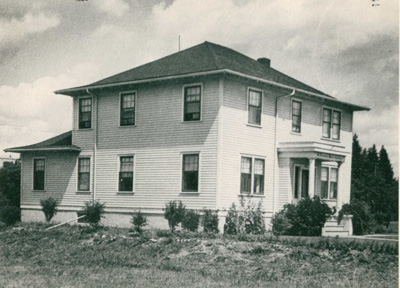 |
| The White House in 1936. |
1942-43
Over the next several years, the college (or STM, as it soon came to be called) grew slowly but steadily in numbers of students, faculty and course offerings. In 1942, the Basilian Congregation agreed to accept STM as a permanent Basilian foundation and to purchase the building and land from the Diocese of Saskatoon. In 1943, St. Thomas More College was incorporated by an act of the Saskatchewan Legislature. That year, an addition was also constructed for the overcrowded white house and for a time, space seemed plentiful. When the influx of World War II veterans arrived at the college in 1945, however, the enlarged white house was once again filled to overflowing with STM students and Newmanites.
From 1936-1956, a total of nineteen Basilians were assigned to St. Thomas More College. In addition to their teaching and chaplaincy roles, many of the Basilian priests became good friends of the students, spending time in conversation, Newman Club activities, Catholic Action study groups, bridge games, Glee club and drama productions - as well as providing breakfast to students after morning Mass.
1953
A financial campaign was launched in 1953 within the Catholic Dioceses of the province to raise funds for a large, permanent, stone building for St. Thomas More College/Newman Club. The first sod was turned by Bishop Francis Klein on Easter Sunday, April 18, 1954. In the weeks and months following, Catholic organizations, parishes, religious congregations, families and individuals throughout the province raised funds and made contributions to pay for the construction costs of the new stone building.
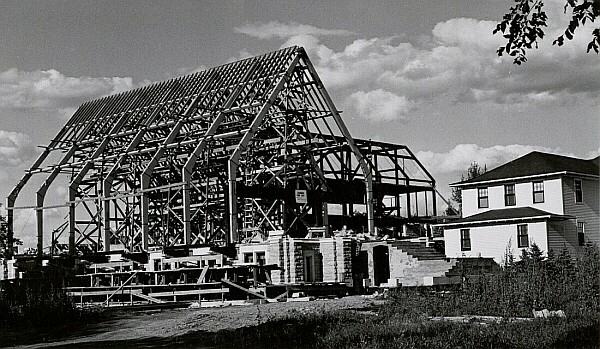 |
| 1955 - A view of the partially constructed Saint Thomas More College Chapel. The original STM building stands to the right. |
1956
With completion of construction in the fall of 1956, STM/Newman moved from the white house into a new, spacious greystone building which included a chapel, Newman clubroom/auditorium, library, office space and a residence area for the Basilian Fathers. The transition marked a new phase in the development of the college, with its now more visible, more dignified physical presence, in harmony with the other greystone buildings on the university campus. The new building was blessed with much celebration. In February, 1957 Newman/STM students and faculty bade a fond farewell to the white house -- that crowded-but-friendly house which had served as a gathering place for Catholic students at the University of Saskatchewan for so long and which, for many, would always be regarded as their first "home away from home".
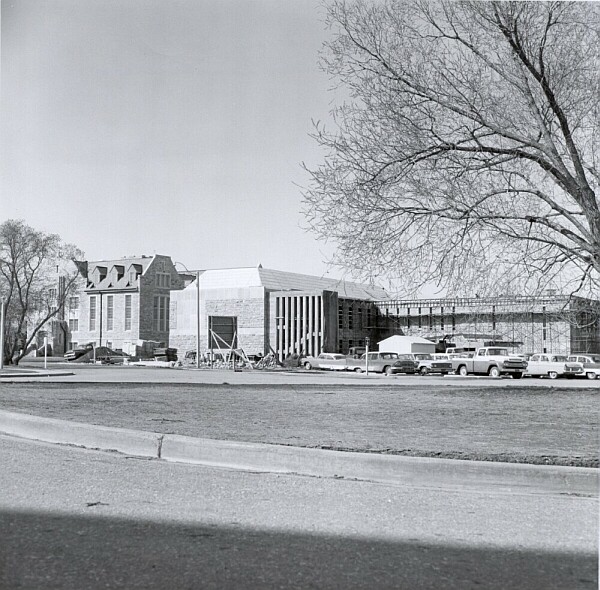 |
| 1963 - Shot of the partially constructed addition to the Saint Thomas More Building. |
2014
The 2014 expansion project was the largest in the past half-century for the College.
In the works since 2012, it added 20,000 square feet for classroom, office and student study areas and enabled the College to respond to individual class enrollments that had reached record levels.
The new addition also provided more office space within the College for faculty and administration including offices which primarily can be used by the college’s social scientists to conduct research trials that require confidential space.
New construction also incorporated cost-saving systems and improvements to technology in the classrooms, with opportunities to offer remote or distance learning.
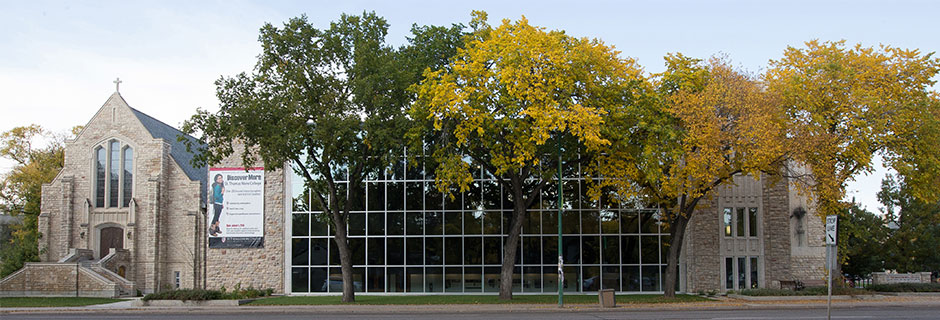 |
| The new addition provides office and classroom space along College Drive |
2017
In 2017 the College celebrated the completion of a $5 million renewal and expansion. The North Building Renewal Project included major additions and renewal to STM’s research library; increased facility energy efficiency, supporting environmental protection; an expansion of the cafeteria, along with additional student-centered space featuring a new lounge and student services hub, plus installation of a 5-story elevator to ensure accessibility throughout the College to the public.
With this project, space was added to the main floor of the STM Library bringing all the collections to one floor and enable expansion of the cafeteria.
A 50-year-old air handling unit, cold winter drafts and lack of an elevator to serve all floors, posed mounting challenges for the College.
The new student lounge and student services hub provide meaningful new student-centered space at STM. Student group offices and a new student lounge form the largest part of the space. The new student center hub reception area for the College created space for student advisors that will be front and center at the College and allow for easier access to Student Services.
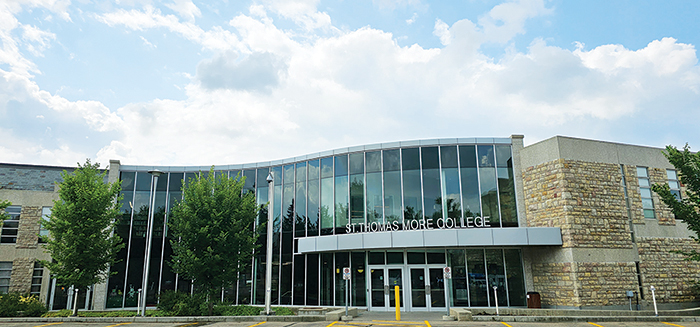 |
| The library, cafeteria and student services areas all grew in 2017 |
Maps
St. Thomas More College is located at 1437 College Drive in Saskatoon Sk on the campus of the University of Saskatchewan.
Saskatoon is centrally located in the province of Saskatchewan, Canada. The city lies 780 kilometres northwest of Winnipeg, a little over 520 kilometres southeast of Edmonton, and just over 300 kilometres north of the U.S. border. Saskatoon is situated on the banks of the south Saskatchewan river which is crossed by seven bridges within the city limits.
